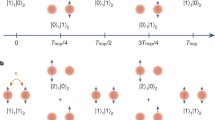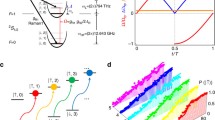Abstract
We propose a method to manipulate the normal modes in a chain of trapped ions using only two lasers. Linear chains of trapped ions have proven experimentally to be highly controllable quantum systems with a variety of refined techniques for preparation, evolution, and readout; however, typically for quantum information processing applications people have been interested in using the internal levels of the ions as the computational basis. We analyze the case where the motional degrees of freedom of the ions are the quantum system of interest, and where the internal levels are leveraged to facilitate interactions. In particular, we focus on an analysis of mode-mixing of phonons in different normal modes to mimic the quantum optical equivalent of a beam splitter.



Similar content being viewed by others
References
S.L. Braunstein, P. van Loock, Quantum information with continuous variables. Rev. Mod. Phys. 77, 513–577 (2005)
H. Häffner, C.F. Roos, R. Blatt, Quantum computing with trapped ions. Phys. Rep. 469(4), 155–203 (2008)
H.-K. Lau, D.F.V. James, Proposal for a scalable universal bosonic simulator using individually trapped ions. Phys. Rev. A 85, 062329 (2012)
J.I. Cirac, P. Zoller, Quantum computations with cold trapped ions. Phys. Rev. Lett. 74, 4091–4094 (1995)
F. Diedrich, J.C. Bergquist, W.M. Itano, D.J. Wineland, Laser cooling to the zero-point energy of motion. Phys. Rev. Lett. 62, 403–406 (1989)
C. Monroe, D.M. Meekhof, B.E. King, S.R. Jefferts, W.M. Itano, D.J. Wineland, P. Gould, Resolved-sideband raman cooling of a bound atom to the 3D zero-point energy. Phys. Rev. Lett. 75, 4011–4014 (1995)
D.J. Wineland, C. Monroe, W.M. Itano, D. Leibfried, B.E. King, D.M. Meekhof, Experimental issues in coherent quantum-state manipulation of trapped atomic ions. J. Res. Natl. Inst. Stand. Technol. 103, 3 (1998)
D.F.V. James, Theory of heating of the quantum ground state of trapped ions. Phys. Rev. Lett. 81, 317–320 (1998)
C. Marquet, F. Schmidt-Kaler, D.F.V. James, Phonon–phonon interactions due to non-linear effects in a linear ion trap. Appl. Phys. B 76(3), 199–208 (2003)
D.P. Divincenzo, The Physical Implementation of Quantum Computation (Wiley, London, 2005)
S. Aaronson, A. Arkhipov, The computational complexity of linear optics. in Proceedings of the Forty-Third Annual ACM Symposium on Theory of Computing, STOC ’11, ACM (New York) (2011), pp. 333–342
M.A. Broome, A. Fedrizzi, S. Rahimi-Keshari, J. Dove, S. Aaronson, T.C. Ralph, A.G. White, Photonic boson sampling in a tunable circuit. Science 339(6121), 794–798 (2013)
J.B. Spring, B.J. Metcalf, P.C. Humphreys, W. Steven Kolthammer, X.-M. Jin, M. Barbieri, A. Datta, N. Thomas-Peter, N.K. Langford, D. Kundys, J.C. Gates, B.J. Smith, P.G.R. Smith, I.A. Walmsley, Boson sampling on a photonic chip. Science 339(6121), 798–801 (2013)
C. Shen, Z. Zhang, L.-M. Duan, Scalable implementation of boson sampling with trapped ions. Phys. Rev. Lett. 112, 050504 (2014)
L. Ortiz-Gutiérrez, B. Gabrielly, L. F. Muñoz, K. T. Pereira, J. G. Filgueiras, A. S. Villar, Continuous Variables Quantum Computation Over the Vibrational Modes of a Single Trapped Ion. ArXiv e-prints (2016)
K. Toyoda, R. Hiji, A. Noguchi, S. Urabe, Hong–Ou–Mandel interference of two phonons in trapped ions. Nature 527(7576), 74–77 (2015)
X. Rebecca Nie, C.F. Roos, D.F.V. James, Theory of cross phase modulation for the vibrational modes of trapped ions. Phys. Lett. A 373(4), 422–425 (2009)
A. Sørensen, K. Mølmer, Entanglement and quantum computation with ions in thermal motion. Phys. Rev. A 62, 022311 (2000)
D.F.V. James, Quantum dynamics of cold trapped ions with application to quantum computation. Appl. Phys. B 66(2), 181–190 (1998)
D.F.V. James, J. Jerke, Effective hamiltonian theory and its applications in quantum information. Can. J. Phys. 85(6), 625–632 (2007)
O. Gamel, D.F.V. James, Time-averaged quantum dynamics and the validity of the effective hamiltonian model. Phys. Rev. A 82, 052106 (2010)
R. Blatt, D. Wineland, Entangled states of trapped atomic ions. Nature 453(7198), 1008–1015 (2008)
C. Monroe, R. Raussendorf, A. Ruthven, K.R. Brown, P. Maunz, L.-M. Duan, J. Kim, Large-scale modular quantum-computer architecture with atomic memory and photonic interconnects. Phys. Rev. A 89, 022317 (2014)
C.K. Hong, Z.Y. Ou, L. Mandel, Measurement of subpicosecond time intervals between two photons by interference. Phys. Rev. Lett. 59, 2044–2046 (1987)
W. Happer, Optical pumping. Rev. Mod. Phys. 44, 169–249 (1972)
D.J. Heinzen, D.J. Wineland, Quantum-limited cooling and detection of radio-frequency oscillations by laser-cooled ions. Phys. Rev. A 42, 2977–2994 (1990)
D.M. Meekhof, C. Monroe, B.E. King, W.M. Itano, D.J. Wineland, Generation of nonclassical motional states of a trapped atom. Phys. Rev. Lett. 76, 1796–1799 (1996)
C. Monroe, D.M. Meekhof, B.E. King, D.J. Wineland, A “schrödinger cat” superposition state of an atom. Science 272(5265), 1131–1136 (1996)
D. Leibfried, D.M. Meekhof, C. Monroe, B.E. King, W.M. Itano, D.J. Wineland, Experimental preparation and measurement of quantum states of motion of a trapped atom. J. Mod. Opt. 44(11–12), 2485–2505 (1997)
W.M. Itano, J.C. Bergquist, J.J. Bollinger, J.M. Gilligan, D.J. Heinzen, F.L. Moore, M.G. Raizen, D.J. Wineland, Quantum projection noise: population fluctuations in two-level systems. Phys. Rev. A 47, 3554–3570 (1993)
D. Leibfried, D.M. Meekhof, B.E. King, C. Monroe, W.M. Itano, D.J. Wineland, Experimental determination of the motional quantum state of a trapped atom. Phys. Rev. Lett. 77, 4281–4285 (1996)
K.E. Cahill, R.J. Glauber, Ordered expansions in boson amplitude operators. Phys. Rev. 177, 1857–1881 (1969)
Acknowledgements
The authors acknowledge support from NSERC and thank Rainer Blatt and Thomas Monz for useful discussions.
Author information
Authors and Affiliations
Corresponding author
Appendices
Appendix 1: Effective Hamiltonian terms
We label the internal state of the \(\ell \)-th ion by the two levels \(|1\rangle \langle 1|_\ell \) and \(|2\rangle \langle 2|_\ell \) and define \({\hat{\sigma }}_3^{(\ell )}=|2\rangle \langle 2|_\ell -|1\rangle \langle 1|_\ell \) as the usual atomic inversion operator. For compactness, we also define \(\varSigma _{ab}=(-1)^a\nu _r+(-1)^b\nu _s-\Delta _1+\Delta _2\). Solving for the terms in the interaction Hamiltonian, we find the following; note that \({\hat{{\mathcal {H}}}}^{(\ell )}_{mn}={\hat{{\mathcal {H}}}}^{(\ell )\dagger }_{nm}\).
As one can see from the above expressions, our protocol relies on a second-order effect. One might worry that terms are missing as a result starting with a first-order Taylor expansion of the full Hamiltonian given in Eq. (18) and then finding effective second-order terms arising from time-ordering. We note that terms second-order in the Lamb–Dicke parameter \({\mathcal {O}}(\eta ^2)\) which would arise from further Taylor expansion would oscillate on the order of the detuning \(\Delta \), and these can be safely neglected as the corrections they would impose would be \({\mathcal {O}}(\eta ^4)\).
Appendix 2: Beyond the Lamb–Dicke approximation
The appropriateness of the Lamb–Dicke approximation can be assessed by a more thorough treatment of our proposed method. The true interaction Hamiltonian is given as
Using an identity [32], we can express \(\varOmega _{n^{\prime}n}=\varOmega \langle n^{\prime}|e^{i\eta (a+a^\dag )}|n\rangle \) as
where \(n_>\) (\(n_<\)) is the greater (lesser) of \(n^{\prime}\) and n, and \(L_n^\alpha \) is the generalized Laguerre polynomial
By noting that
we can now write the Hamiltonian as
where we denote \(\varGamma =n^{\prime}-n\) to emphasize that terms with fixed \(\varGamma \) have the same frequency. Motivated by this, we can express the interaction as
where
Provided the detuning \(\Delta \) dominates this frequency over some appropriate range of \(\varGamma \), such as if we had an upper bound on the number of phonons, then we can again appeal to the effective Hamiltonian approach. We can then compare these results to the results obtained in the Lamb–Dicke approximation.
For example, we compare the term containing \(\eta {\hat{\sigma }}_+^{(\ell )}{\hat{a}}\) obtained in the Lamb–Dicke approximation to the corresponding term in Eq. (26). The former will have the matrix element \(\eta \langle n^{\prime}|{\hat{a}} |n\rangle =\eta \sqrt{n}\delta _{n^{\prime},n-1}\) whereas the latter will have
For the case of \(\varGamma =-1\) we find that \(\lim _{\eta \rightarrow 0}\varOmega _{n-1,n}\approx \eta \sqrt{n}\) as desired and all other transitions are suppressed by a factor of \(\eta ^{|\varGamma |}\). Deviations from the first-order approximation can then be characterized by the how these matrix elements differ from the creation and annihilation operators assumed in the more simple treatment.
One can account for the transverse modes by adding additional terms to the exponential in Eq. (20), and these terms will give rise to similar terms \({\hat{h}}_\varGamma \) in the effective Hamiltonian picture, i.e., phase shifts, beam splitters, and squeezing operations. As presented in Sect. 5, these motional modes can be expressed in terms of the normal modes of the chain.
Rights and permissions
About this article
Cite this article
Marshall, K., James, D.F.V. Linear mode-mixing of phonons with trapped ions. Appl. Phys. B 123, 26 (2017). https://doi.org/10.1007/s00340-016-6601-y
Received:
Accepted:
Published:
DOI: https://doi.org/10.1007/s00340-016-6601-y




